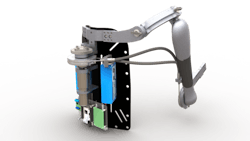Wireless Exoskeleton Wins 2013 Cornell Cup USA
The Cornell Cup USA is a college-level embedded engineering competition, hosted by Cornell University in partnership with Intel, which was created to help student teams become inventors of new, innovative applications for intelligent systems. The projects must address real-world needs and provide business-ready solutions.
This year’s competition featured 30 teams from 18 universities, with the students from each university dedicating six months to the projects—from conception and design to construction and iterations. Throughout the process, the teams had access to Intel Atom boards and input from Intel technical leaders with experience in designing and developing embedded hardware and applications.
Taking first place in the competition this year, along with the $10,000 prize, was the University of Pennsylvania Engineering Team with its Titan Arm project. The Titan Arm is a type of exoskeleton system used in physical therapy, search and rescue operations, as well as physically intensive occupations requiring heavy lifting. Many existing exoskeleton systems are considered to be bulky, expensive and invasive. Thus the University of Pennsylvania sought to deliver a low-cost, wireless and ergonomic upper-body exoskeleton solution with onboard sensing to provide rich data. Team members from the University of Pennsylvania are: Elizabeth Beattie, Nick McGill, Nick Parrotta and Niko Vladimirov.
Second-place honors at the competition and $5,000 went to Ross Desmond, Matthew Dickerman and James Fleming of Worcester Polytechnic Institute for their Cyber Physical Systems semi-autonomous wheelchair. The wheelchair is combined with a body-brain interface and uses cost-effective, modular sensor packages that can be mounted to a variety of commercially available wheelchairs.
Third-place and $2,500 went to Kyle Dunn, Ben Larkin, Rich McLean, Monte Smith, and Jeff Wiencrot of the University of Colorado, Denver for their Intracell project. The Intracell is comprised of networked cell phone transceiver nodes that function together as a local extension to the global cellular network to provide coverage to areas normally blocked by geographical and architectural constraints.
A panel of experts from Intel and Cornell Engineering judged all teams.
Learn more about the Cornell Cup USA and all of this year’s finalists.
About the Author
David Greenfield, editor in chief
Editor in Chief

Leaders relevant to this article:
